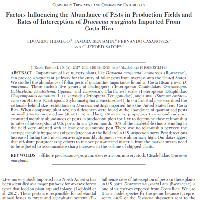Resumen
-
Importation of live nursery plants, like Dracaena marginata Lamoureux (Ruscaceae), can provide a significant pathway for the entry of foliar pests from overseas into the United States. We studied the abundance of foliar pests of quarantine importance found on Costa Rican-grown D. marginata. These include five genera of leafhoppers (Heteroptera: Cicadellidae, Oncometopia, Caldweliola, Diestostema, Gypona, and Empoasca), Florida red scale (Heteroptera: Disapididae, Chrysomphalus aoinidum (L.)), katydids (Orthoptera: Tettigoniidae), and a snail (Succinea costarricana von Martens (Gastropoda, Stylommatophora, Succineidae)). In our first study, we examined the rationale behind size restrictions on Dracaena cuttings imported into the United States from Costa Rica. When comparing plant size, no differences were found in the abundance of quarantined pests on small (15–46 cm), medium (46–81 cm), and large (81–152 cm) propagules. In a second study, we estimated monthly abundances of pests in production plots for 1 yr to determine their relationship to rates of interception at U.S. ports. In any given month, <6% of the marketable shoots standing in the field were infested with at least one quarantine pest. There was no relationship between the average monthly frequencies of pest detection in the field and in U.S. inspection ports. Pest detections increased during the 1 mo when average monthly shipments were abnormally high. Our data suggest that off-shore postprocessing efforts to remove pest-infested material from the market stream need to be adjusted to accommodate sharp increases in the volume of shipped plants.
